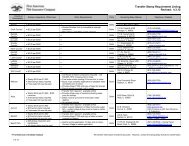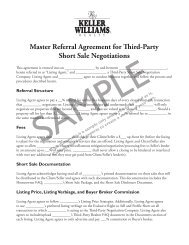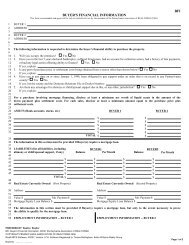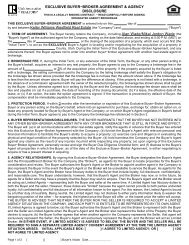The DISC and Communication - Keller Williams Realty
The DISC and Communication - Keller Williams Realty
The DISC and Communication - Keller Williams Realty
You also want an ePaper? Increase the reach of your titles
YUMPU automatically turns print PDFs into web optimized ePapers that Google loves.
<strong>The</strong> <strong>DISC</strong> <strong>and</strong><strong>Communication</strong>kwu@kw.comImprove <strong>Communication</strong> by Anticipating <strong>and</strong> Adopting Behavior Styles
NOTICESWhile <strong>Keller</strong> <strong>Williams</strong> <strong>Realty</strong>, Inc. (KWRI) has taken due care in the preparation of all coursematerials, we do not guarantee its accuracy now or in the future. KWRI makes no warrantieseither expressed or implied with regard to the information <strong>and</strong> programs presented in thecourse, or in this manual, <strong>and</strong> reserves the right to make changes from time to time.This manual <strong>and</strong> any course it’s used as a part of may contain hypothetical exercises that aredesigned to help you underst<strong>and</strong> how <strong>Keller</strong> <strong>Williams</strong> calculates profit sharing contributions<strong>and</strong> distributions under the MORE System, how <strong>Keller</strong> <strong>Williams</strong> determines agentscompensation under the <strong>Keller</strong> <strong>Williams</strong> Compensation System, <strong>and</strong> how other aspects of a<strong>Keller</strong> <strong>Williams</strong> Market Center’s financial results are determined <strong>and</strong> evaluated. Any exercisesare entirely hypothetical. <strong>The</strong>y are not intended to enable you to determine how much moneyyou are likely to make as a <strong>Keller</strong> <strong>Williams</strong> Licensee or to predict the amount or range of salesor profits your Market Center is likely to achieve. <strong>Keller</strong> <strong>Williams</strong> therefore cautions you not toassume that the results of the exercises bear any relation to the financial performance you canexpect as a <strong>Keller</strong> <strong>Williams</strong> Licensee <strong>and</strong> not to consider or rely on the results of the exercisesin deciding whether to invest in a <strong>Keller</strong> <strong>Williams</strong> Market Center. If any part of this notice isunclear, please contact <strong>Keller</strong> <strong>Williams</strong>’ legal department.Materials based on the Recruit-Select-Train-Manage-Motivate (RSTMM) system <strong>and</strong> theWinning Through Selection course have been licensed to <strong>Keller</strong> <strong>Williams</strong> <strong>Realty</strong> International byCorporate Consulting. KWRI has the exclusive right within the residential real estate industryto market <strong>and</strong> present material from RSTMM, Winning Through Selection, <strong>and</strong> any derivativesowned by or created in cooperation with Corporate Consulting.Material excerpted from <strong>The</strong> Millionaire Real Estate Agent appears courtesy of <strong>The</strong> McGraw-HillCompanies. <strong>The</strong> Millionaire Real Estate Agent is copyright © 2003–2004 Rellek PublishingPartners LTD. All rights reserved.Copyright noticeAll other materials are copyright © 2009 <strong>Keller</strong> <strong>Williams</strong> <strong>Realty</strong>, Inc. All rights reserved.Printed June 2009.No part of this publication <strong>and</strong> its associated materials may be reproduced or transmitted in anyform or by any means without the prior permission of <strong>Keller</strong> <strong>Williams</strong> <strong>Realty</strong> Inc.© 2009 KELLER WILLIAMS REALTY INC. ii
<strong>The</strong> <strong>DISC</strong> <strong>and</strong> <strong>Communication</strong><strong>The</strong> <strong>DISC</strong>Assessing Preferred Behavior<strong>The</strong> <strong>DISC</strong> is a great tool to utilize when trying to match a talented individualwith a specific role. However, the <strong>DISC</strong> is not exclusive to the hiring process.If you’d like to communicate more effectively with others around you, such asfamily members, community volunteers, loan officers, etc. consider assessingtheir behavior as well.Tip!<strong>Keller</strong> <strong>Williams</strong> <strong>Realty</strong> also utilizes a behavioral assessment toolcalled the Activity Vector Analysis, or AVA. Learn more abouthow to use this tool in the KWU course, RecruitSelect. Seehttp://kwu.kw.com/recruitselect for more information.<strong>The</strong> <strong>DISC</strong> is a behavior or personality assessment that provides feedback abouthow individuals communicate <strong>and</strong> relate to one another <strong>and</strong> how they willbehave under stress. <strong>The</strong> four behavioral styles assessed by the <strong>DISC</strong> are:• D (Drive)—Characterized by dominance, drive, need to conquer; quickto anger; motivated by challenge <strong>and</strong> bottom line; thinking- <strong>and</strong> taskoriented;fast <strong>and</strong> aggressive; fears looking like a fool or being takenadvantage of.• I (Influence)—Characterized by influence, persuasiveness, <strong>and</strong>optimism; motivated by flattery <strong>and</strong> recognition; people- <strong>and</strong> relationshiporiented;fast <strong>and</strong> aggressive; fears rejection.• S (Steadiness)—Characterized by steadiness, supportiveness, calm;hides emotions; motivated by benefits; people- <strong>and</strong> relationship-oriented;steady <strong>and</strong> cautious; fears change.• C (Compliance)—Characterized by compliance <strong>and</strong> correctness; avoidsrisk; motivated by accuracy; thinking- <strong>and</strong> task-oriented; steady <strong>and</strong>cautious; fears criticism.<strong>The</strong> <strong>DISC</strong> assessment analyzes behavioral characteristics <strong>and</strong> plots them asfour variables on a graph. <strong>The</strong> person’s profile type is determined by readingthe highest point or score on the graph, then the next highest, <strong>and</strong> so forth.<strong>The</strong> <strong>DISC</strong> graph includes a 50 percent line or an Energy Line. This line is usedto determine the key characteristics of a person’s profile. You will often hearcharacteristics referred to as “above the line” or “below the line.”Note: To order <strong>DISC</strong> assessments, visit www.abelson.net.© 2009 KELLER WILLIAMS REALTY INC. 1
<strong>The</strong> <strong>DISC</strong> <strong>and</strong> <strong>Communication</strong>© 2009 KELLER WILLIAMS REALTY INC. 2
<strong>The</strong> <strong>DISC</strong> <strong>and</strong> <strong>Communication</strong>Team <strong>Communication</strong><strong>The</strong> High D Is Looking for RESULTS/EFFICIENCYWhen working <strong>and</strong> communicating with individuals who exhibit a high Dbehavior, remember that they are direct, self-reliant, <strong>and</strong> competitive. <strong>The</strong>y arehigh risk takers <strong>and</strong> are task-oriented. <strong>The</strong>y have a desire to change theenvironment around them <strong>and</strong> they have a great sense of urgency.When working with a High I, a High D must allow the High I to verbalize <strong>and</strong>allow a bit more time for the decisions to be made. D individuals will need tolighten up when dealing with I profiles.A High D will need to slow down their pace when interacting with S profiles.<strong>The</strong> High D might frequently overpower the High S because of the High D’ssense of urgency <strong>and</strong> high risk.<strong>The</strong> High D will need to slow down to have successful communication withthe High C. <strong>The</strong> High D needs to give more information than normal, but nottalk too personally with the High C or be too pushy. Both the High D <strong>and</strong> theHigh C share a need to use time wisely <strong>and</strong> to control their environment.<strong>The</strong> High I Is Looking for the EXPERIENCEHigh I individuals are people-oriented <strong>and</strong> tend to be very verbal <strong>and</strong>persuasive. <strong>The</strong>y may have creative high-risk ideas, but some may not carry outthe ideas. A High I enjoys people <strong>and</strong> fun. <strong>The</strong>y ask lots of questions.<strong>The</strong> High I will need to be more direct with a High D. Also, the I will need toallow the D to carry the conversation, <strong>and</strong> work on asking more questionsinstead of telling the answers.When working with a High S, the High I must talk less <strong>and</strong> ask more questionsto build a trust relationship. <strong>The</strong>se individuals need to be careful not to appeartoo pushy or enthusiastic to S profiles.When working with a High C, the High I will have to slow down, keep a tightrein on emotions, <strong>and</strong> provide the necessary data to the High C. Personal talk isnot allowed, as the private life of the High C is exactly that—private.© 2009 KELLER WILLIAMS REALTY INC. 3
<strong>The</strong> <strong>DISC</strong> <strong>and</strong> <strong>Communication</strong>Below is a chart of tips on the best way to communicate with each style.Remember, you may have to blend some of the ideas listed below. Very fewpeople have just one preferred style.IWhen communicating with a personwho is magnetic, enthusiastic,friendly, demonstrative, <strong>and</strong> political:• Provide a warm <strong>and</strong> friendlyenvironment.• Don't deal with a lot of details(put them in writing).• Ask "feeling" questions to drawtheir opinions or comments.DWhencommunicating with a personwho is ambitious, forceful, decisive,strong willed, independent, <strong>and</strong> goaloriented:• Be clear, specific, brief, <strong>and</strong> to thepoint.• Stick to business.• Be prepared with support materialin a well-organized "package."Factors that will create tension ordissatisfaction:Factors that will create tension ordissatisfaction:• Being curt, cold, or tight lipped.• Controlling the conversation.• Driving on facts <strong>and</strong> figures,alternatives, abstractions.• Being giddy, casual, informal, loud.• Pushing too hard or beingunrealistic with deadlines.• Being disorganized or messy.SWhen communicating with a personwho is patient, predictable, reliable,steady, relaxed, <strong>and</strong> modest:• Begin with a personalcomment—break the ice.• Present your case softly, nonthreateningly.• Ask "how?" questions to drawtheir opinions.Factors that will create tension ordissatisfaction:• Rushing headlong into business.• Being domineering ordem<strong>and</strong>ing.• Forcing them to respond quicklyto your objectives.CWhencommunicating with a personwho is dependent, neat, conservative,careful, <strong>and</strong> compliant:• Prepare your "case" in advance.• Stick to business.• Be accurate <strong>and</strong> realistic.Factors that will create tension ordissatisfaction:• Talking about things that are notrelevant to the issue.• Leaving loopholes or cloudy issues.• Appearing disorganized.Abelson & Company1-888-ABELSON (223-5766) / Fax 1-979-696-2272abelson@abelson.netCopyright © 1984-2004. Target TrainingInternational, Ltd.© 2009 KELLER WILLIAMS REALTY INC. 5
















